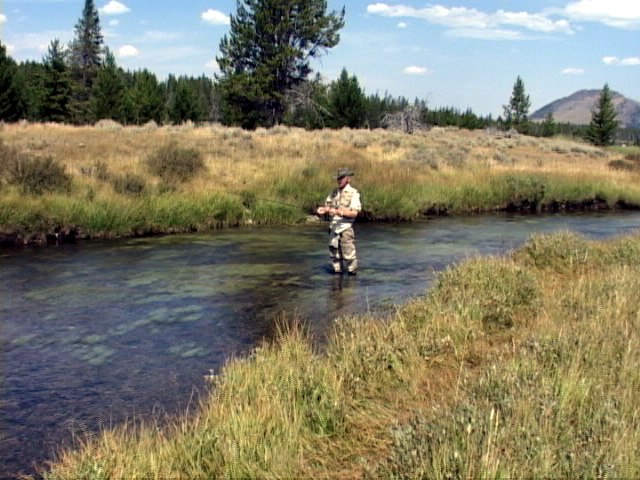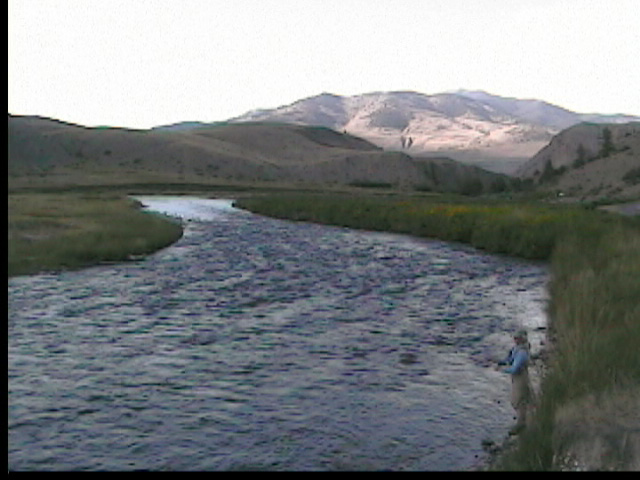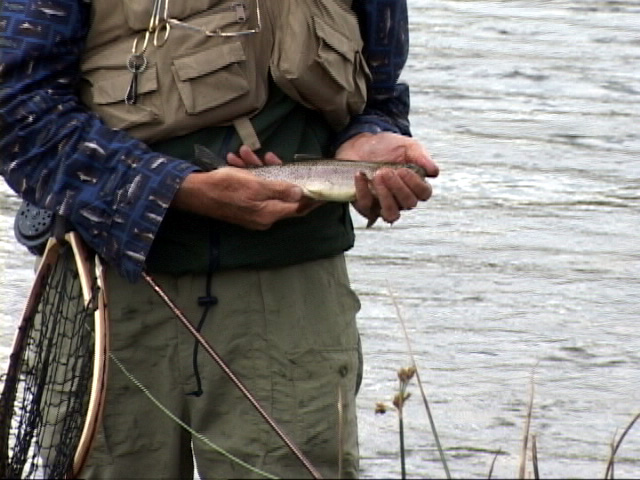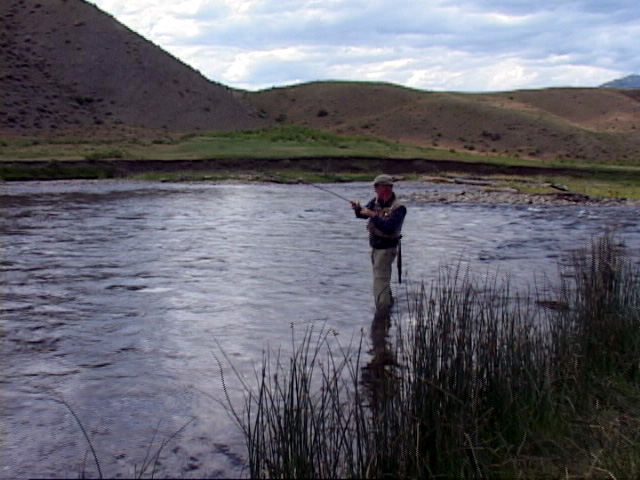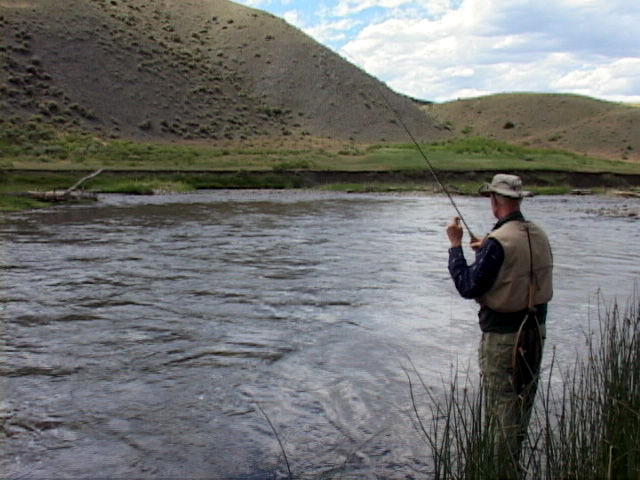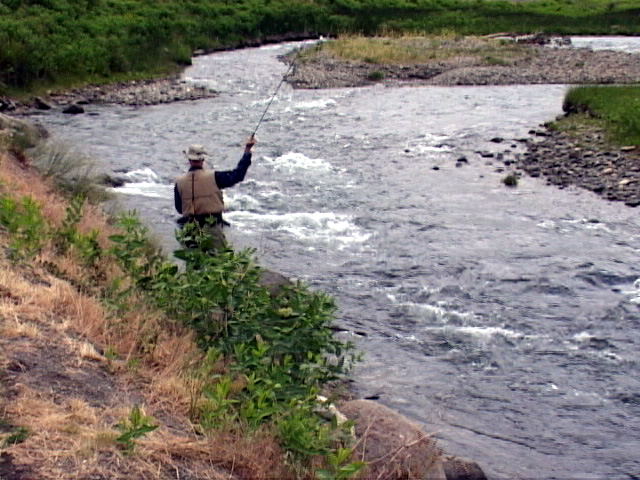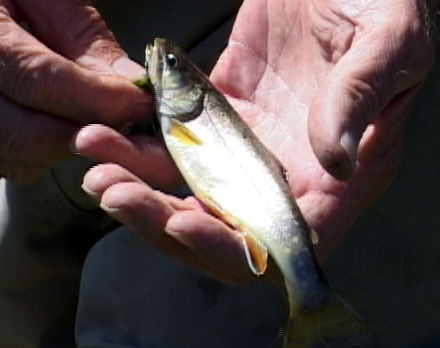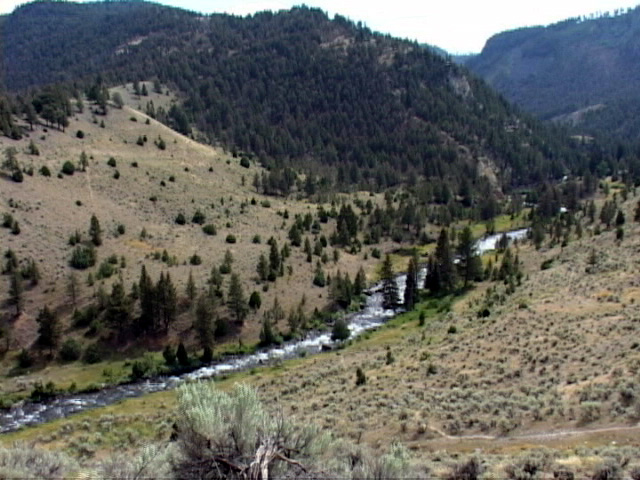
section of the Gardner can be
accessed fairly easy.
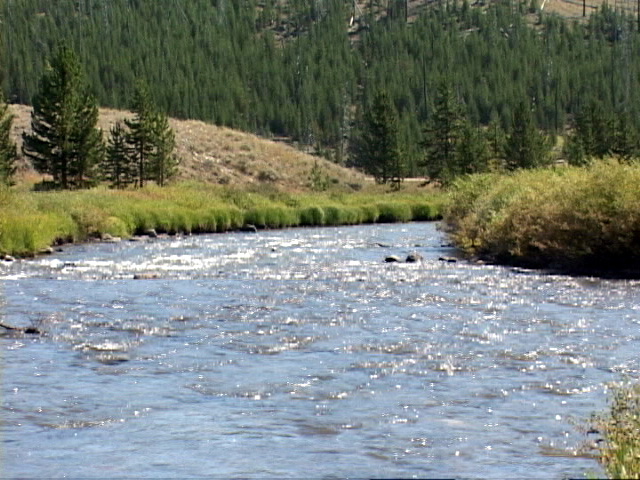
above Gardner Canyon.
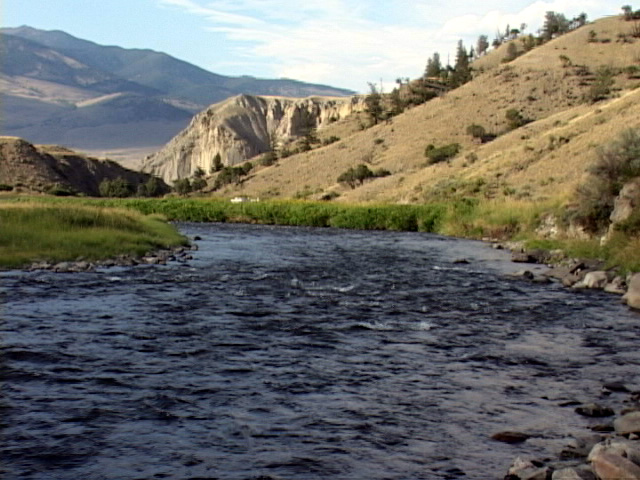
from its confluence with the
Yellowstone River.
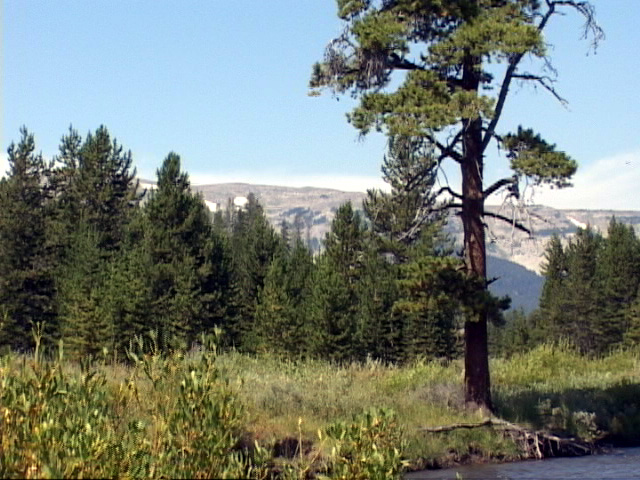
The Gardner River starts from small
streams that flow from the Gallatin
Range seen in the background.
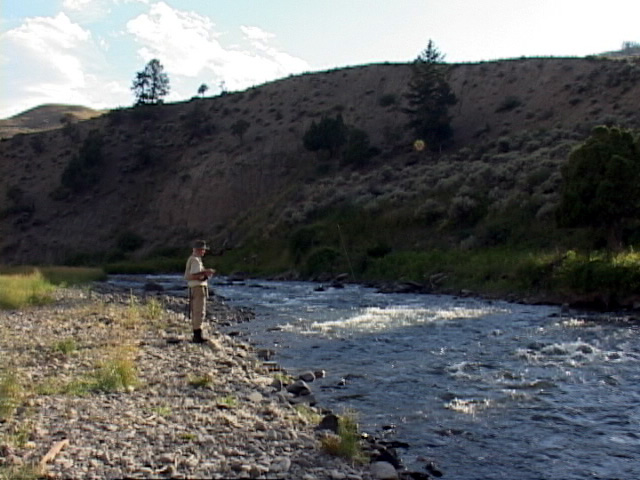
quite turbulent where it narrows
and bends.
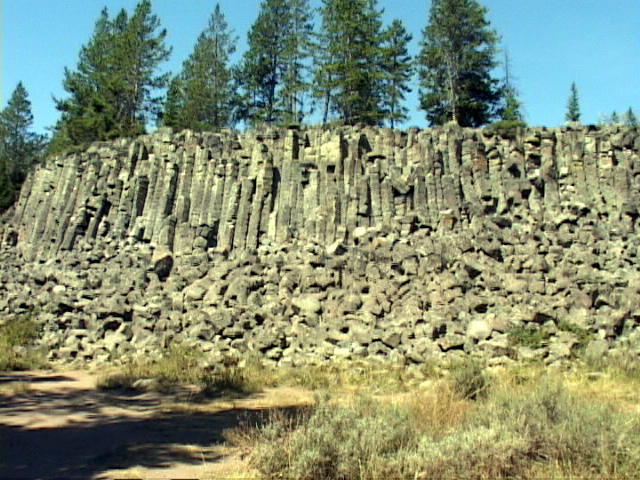
parallel with the Gardner River.
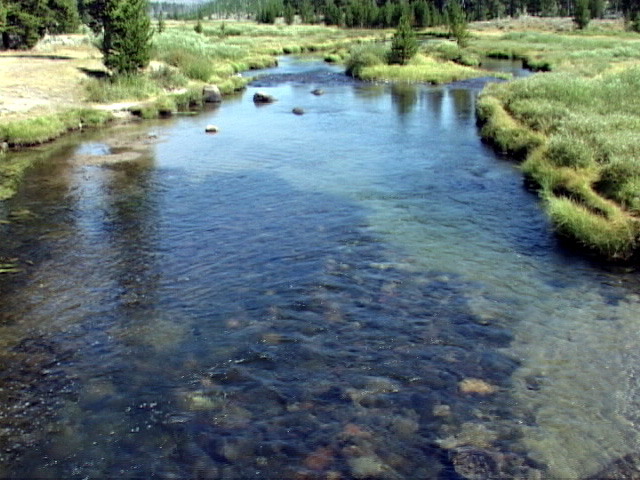
smaller brook trout streams that
flows into the Gardner River. This
small meadow stream is full of
small brook trout.
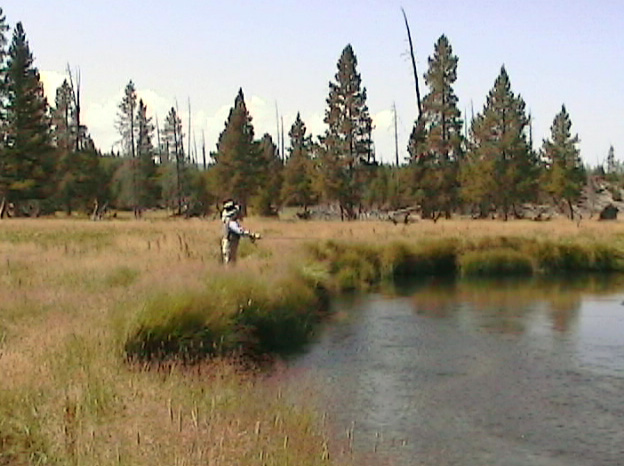
meadow stream that has lots of
brook trout.
The Gardner River is located in the Northwestern portion of Yellowstone National Park. It begins at an elevation of about 10,000 feet from several small streams on the Gallatin Range that merge together. The small river flows for several miles before it reaches the bridge at the Mammoth-Norris Road located about 7 miles south of Mammoth. Most of the fish above this point are smaller size brook trout.
Click here for Additional Info on the Gardner River
Sheepeater Canyon:
East of the Mammoth-Norris Road the Gardner flows into the Sheepeater Canyon. The head of the canyon lies just a short distance of a mile or so downstream of the bridge. Sheepeater Canyon is a 6-mile long deep canyon stretch with a 100-foot high waterfall, Ospray Falls, which is located near the center of the canyon. Above the falls the banks of the stream are very steep and the fish are all brook trout. Below Ospray Falls, the trout are mostly rainbows that average about 10 to 12 inches and sometimes better. There are also some brook trout below the falls. Farther down the Gardner River towards the Mammoth-Tower Road, the fish are a mixture of rainbows and brown trout.
Gardner Canyon:
The lower Gardner River, below the high bridge about a mile and a half east of Mammoth on the Mammoth-Tower Road, flows for 5 miles before it reaches the Yellowstone River. The fish in this section of the river are a combination of rainbows, browns, cutthroats, cuttbows, brook trout and whitefish. These fish average 8 to 14 inches in length. During the fall from about the middle of September until the end of the season, large brown trout move out of the Yellowstone River up into the Gardner River to spawn. They can be caught as far up as the base of Ospray Falls during this spawning migration. The migrating brown trout in the Gardner are much larger than the resident brown trout are. Browns can be taken up to 20 inches and even larger.
Gardner Canyon Access:
You can reach the upper end of this section of the river at the high bridge and hike either upstream or downstream. Another access to this area is at the Lava Creek Trailhead. The trail located across from the Mammoth Campground, leads to a footbridge on the Gardner River. From there you can fish upstream along the trail. There is also an access located below the Mammoth Housing area that will take you to the stream.
The 45th Parallel Bridge, located about 2 and a half miles from the North Entrance on the North Entrance Road, provides the next downstream access to the river. There is a parking area and a trail that leads upstream to Boiling Springs that follows along the river. Downstream of the bridge is an area of meadows and sagebrush but the river is certainly not what you would call a meadow stream. From the 45th Parallel Bridge to the entrance to the park, the river is made up of high gradient plunges, runs and riffles as the stream falls down the mountain to the Yellowstone River rather fast. The road follows the stream closely and there are several places anglers can pull off the road to fish the river. The stream could best be described as fast pocket water.
Tributaries:
The Gardner River has a large number of tributary streams from its headwaters to its confluence with the Yellowstone River.
Click here for Additional Information on the following Tributaries
Fawn Creek:
The Gardner is joined by Fawn Creek, its first major tributary stream, before it enters the Indian Creek Campground vicinity. This area is located about a half mile from the Grand Loop Road about 7 miles south of Mammoth, Montana. All the fish in Fawn Creek are small brook trout.
Indian Creek:
Near the Indian Creek Campground the Gardner River picks up more water from Indian Creek. Sage and scrub willows line this small meadow stream. The trout in Indian Creek are all brook trout that average 6 to 8 inches long.
Panther Creek:
Panther Creek also joins the Gardner in the Indian Creek Campground area. It is a small meadow stream that is very similar to Indian Creek that flows only a short distance away. The fish in Panther Creek are all small brook trout.
Obsidian Creek:
Just above the bridge over the Gardner on the Mammoth-Norris Road, Obsidian Creek also enters the Gardner River. It is a slow moving, willow tree lined stream. Brook trout are the only species of fish in the creek and they are mostly small. It’s accessible from the Moose Exhibit area on the Mammoth-Tower Road about 11 miles north of Norris Junction.
Winter Creek:
Winter Creek is a small tributary stream that flows into Obsidian Creek. Its fish are brook trout that average from 6 to 9 inches. It is also accessible from the Moose Exhibit area on the Grand Loop Road about 11 miles north of Norris Junction.
Straight Creek:
Straight Creek is a small meadow steam that flows North into and out of Grizzly Lake. Below Grizzly Lake the stream merges with Winter Creek. Its trout are all small brook trout. The mouth of the stream is accessible by following Winter Creek upstream to its confluence with Winter Creek.
Glenn Creek:
Glenn Creek is a very small stream that joins the Gardner River about a half mile above the Sheepeater Canyon Bridge, on the Mammoth-Tower Road. Trout in this stream are all small brook trout except for a few rainbows and cutbows near the stream’s confluence with the Gardner River. It can be accessed from bridge that is located about a mile and a half west of Mammoth on the Mammoth-Tower Road. From there you can hike upstream along the Gardner River to the mouth of Glenn Creek.
Lava Creek:
Lava Creek is a larger size tributary stream. See the Lava Creek page.
Comments:
The portion of the stream above the Mammoth/Norris Junction road contains brook trout only and maybe an occasional small rainbow trout. The trout in the Gardner River in the campground area and the lower sections of its several tributary streams are as large as they are going to get anywhere above the bridge. Although there are several miles of the Gardner River above the 7 Mile Bridge to the beginning of its headwaters, there are few large fish. Fishing the upper portion may be fun from a “get away from it all” standpoint but from a pure fishing standpoint, you could do much better in the lower portion of the river below the high bridge on the Grand Loop Road to Tower Junction.
Click here for Additional Info on the Gardner River
Copyright James Marsh 2011
